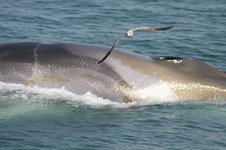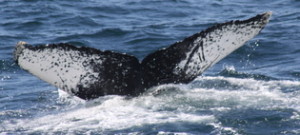Dolphin Fleet Naturalist Notebook 22 May to 28 May
May 22 was cloudy but clear, and the Dolphin VIII and the Portuguese Princess II headed northeast, ending up just south of the Stellwagen Bank National Marine Sanctuary. When cold, nutrient-rich currents move southward from Canadian waters, they collide with underwater structures such as Stellwagen Bank, circulating nutrients and creating a chain-reaction of productivity. Phytoplankton blooms feed zooplankton, which in turn feed the fish upon which the whales feast. Today, the effects of this food web were obvious. Along the southern edge of Stellwagen Bank, Humpback whales lunged at the surface, feeding upon massive schools of sand eels. Naturalist Nancy Scaglione-Peck reports that the humpbacks were “spread out and chowing down”, making it difficult to keep track of how many whales were in the area. Throughout the day, it was estimated that at least 50 humpback whale individuals were seen!

On May 23rd, the sun had reappeared and the winds had died down, but the humpback whale feeding frenzy continued. We noticed that several of our humpbacks, including Broomball and Tongs, were employing a very specific feeding technique known as kick-feeding. When humpback whales kick-feed, they will smack the water with their enormous tails, scaring and stunning the small schooling fish that they will then engulf.

While kick-feeding is now a relatively frequent sight among Gulf of Maine humpbacks, this wasn’t always the case. Regular kick-feeding was first observed in the mid to late 1980s, and was thought to coincide with the shift of the humpback’s primary food source from herring to sand lance. In other words, it seems that humpbacks will employ different feeding techniques in response to varying food availability, and, perhaps even more interestingly, can learn these successful feeding techniques from each other!
Anyone who goes on repeated whale watches knows that conditions can change in an instant, and today was no exception. Despite the huge number of humpbacks seen during the morning, we returned in the afternoon to find that they had cleared the area, with only a few large whales to be found. We did, however, find a large pod of Atlantic white-sided dolphins, which soon encircled the boat!
When we set sail the following morning, on May 24th, we found that the whales, as well as many of the dolphins, had moved south east, just off the Peaked Hill Bars, likely in hot pursuit of more food. Ventisca, a humpback easily recognized by the white pigment on her dorsal fin, back, and fluke, blew columns of bubbles, surfacing in the middle of the bubbles with a mouth full of food. Meanwhile, a pod of Atlantic white-sided dolphins swam among the humpbacks, likely attracted to the same group of small schooling fish.

Unlike dolphins, humpbacks don’t tend to travel in long-lasting social groups. When we see large groups of humpbacks, it tends to be when they have all converged on a massive school of fish. Today, our naturalist Mike Bertoldi estimated that between 40 and 50 humpbacks were feeding within a mile radius!
On May 25th, we were delighted to find that the humpbacks were still chowing down south of of Stellwagen Bank! On the 10am trip, we also had a chance to see one of the first basking sharks of the season. Basking sharks are the second largest fish on the planet, but despite their threatening appearance, they pose little risk to humans. Like the sei and right whales, they feed on zooplankton, such as calanoid copepods. As they open their mouths, water rushes over their gills, and plankton gets trapped in their modified gill-rakers. Basking sharks were named for their tendency to “bask” at the water’s surface; however, recent tagging studies have shown that they spend much of the winters lurking in deep equatorial trenches!
Afternoon excursions saw 4 different species of whale: humpbacks, dolphins, Minkes, and fin whales. Fin whales are the second largest animal on the planet (second in size only to the blue whale), and can be seen off the coast of Cape Cod throughout the year. They are famously elusive, but sharp eyes can catch them cruising along Race Point beach in Provincetown, often in pairs.

By May 26th, the feeding had subsided, but there were still many whales in the area. The morning trip gave us excellent looks at humpbacks, fin whales, as well as 15 to 20 Minke whales! Minke whales are the smallest baleen whale commonly seen in the Stellwagen Bank region, and although we see them frequently, we often don’t get very good looks, as they are fast, and unpredictable. Today, we got one of the best looks at a Minke many of our whale watch veterans had ever seen. As we sat and waited for a humpback to resurface, a Minke whale emerged near the bow of our boat, and surfed along with us as we slowly started to steam northward! Even once we had stopped, the Minke swam back and forth beneath our boat, giving our passengers an unusual close boat approach!

Later, upon traveling to the same vicinity, we found that the huge group of Minkes had dissipated, but a few more humpbacks had moved into the area. We were alerted to their position when a giant white flipper rose out of the water. A tell-tale sign that a Megaptera novaeangliae (the scientific name for a humpback whale, meaning big-winged New Englander) was in the vicinity. Once the whale rolled over and fluked, we realized that it was Sloop, a 23 year-old female humpback. Sloop is named for the sailboat-shaped marking on her fluke (a sloop is a single-masted sailboat). She was joined by Tear, as well as a third humpback who never raised its flukes long enough for us to get an identification-quality photo!

On May 28th we returned to our whale watching vantage point on the southeast corner of Stellwagen Bank, otherwise known as the “Triangle”. There, we found a small humpback named Bayou. Bayou’s flukes have sustained major injury as a result of a ship strike, and only her left fluke remains in tact. Unfortunately, collisions with vessels remain a leading cause of mortality and injury for many of the large whales who visit the Gulf of Maine. Dolphin Fleet Whale Watch captains follow strict guidelines to ensure the safety of our whales during our excursions.
On a happier note, we also encountered Whisk and her new calf. Humpback whale calves are born in tropical waters during the winter, and accompany their mothers back up north to the feeding grounds, where they will continue to nurse throughout the summer. While this whale migration happens yearly, not all humpbacks migrate at once. While many of our humpbacks arrived over a month ago, we recently received word that colleagues tracking tagged humpbacks in southern breeding areas received a signal transmission from a humpback whale that, as of this week, was still about 1000 km northeast of Guadeloupe!





